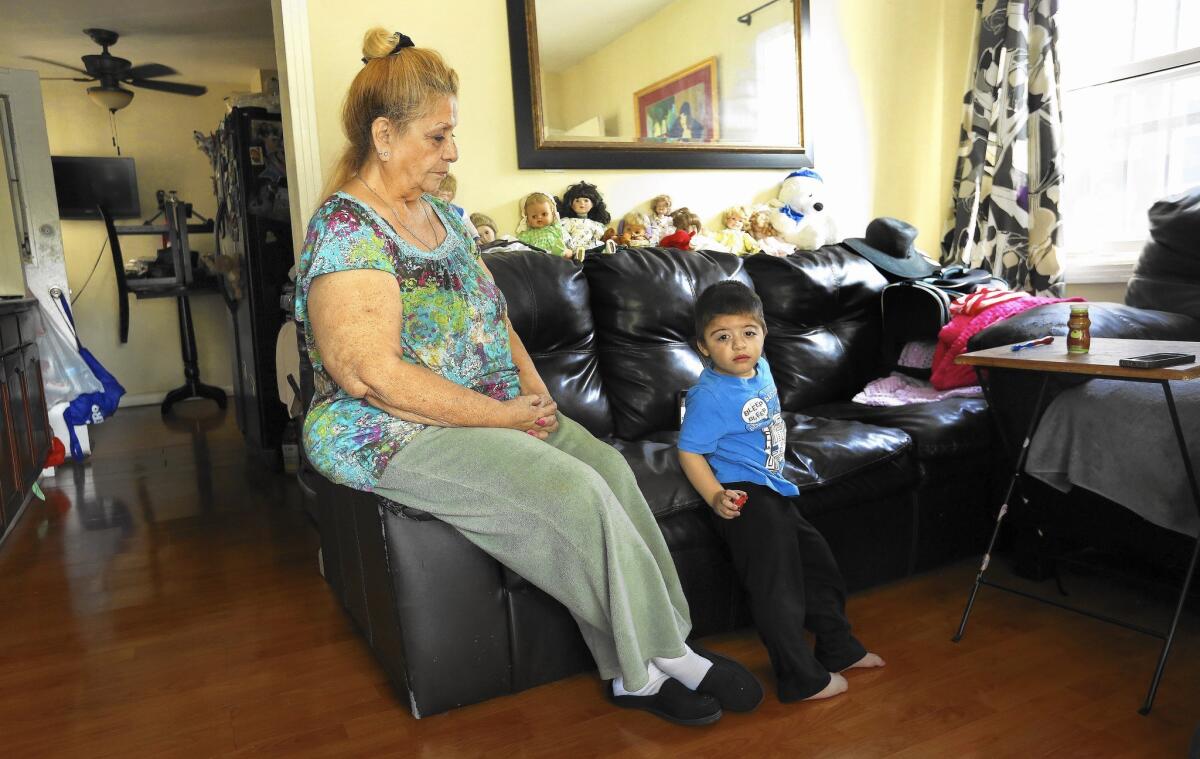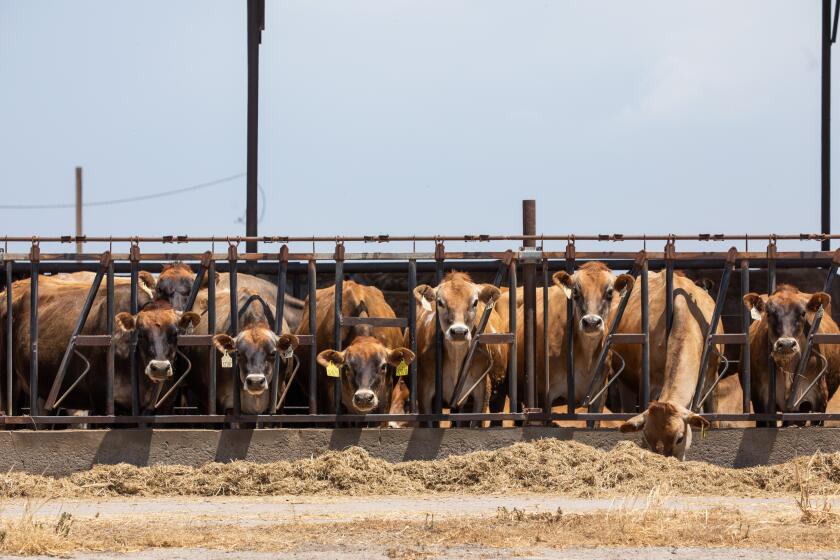State isn’t using blood-test data that could help focus Exide cleanup efforts

The Los Angeles County Health Department in March collects soil samples to be tested for possible lead contamination from the nearby and now-closed Exide battery plant.
- Share via
The state of California has blood test results showing high levels of lead in children living near the closed Exide battery plant in Vernon but is not using the information to direct its massive cleanup of lead-contaminated homes and yards.
Health experts say the test results should be used to help pinpoint neighborhoods most in need of swift cleanup because children there have been exposed to more of the poisonous metal. Lead, which spewed for decades from the Exide Technologies recycling facility, is especially dangerous to young children, putting them at risk of lifelong developmental and behavioral problems.
Blood-testing data have guided government responses to lead contamination elsewhere. In Flint, Mich., the state is using maps of children’s blood lead levels to target neighborhoods hardest hit by the city’s lead-contaminated drinking water.
But in California, officials have been unable to launch a similar effort. The California Department of Toxic Substances Control said it has tried unsuccessfully for more than two years to obtain blood lead levels from state and county health agencies, which keep the records.
In September, 13 months after the cleanup began, it formally requested census tract-level data but still hasn’t received it from state health officials. So the department is relying on soil tests, wind patterns and proximity to the plant to guide its cleanup of thousands of homes.
The state Department of Public Health has yet to provide the information, according to toxics regulators. The health agency said it is prohibited by medical privacy law from releasing data showing individual test results but is finalizing an extensive analysis of whether people in census tracts near the Exide plant have increased blood lead levels.
The toxic substances department said it knows of only two children — a baby and a toddler — who have had high levels of lead in their blood across the contaminated southeast Los Angeles County communities of Bell, Boyle Heights, Commerce, East Los Angeles, Huntington Park, Maywood and Vernon. Officials learned of the children because their families told the department about their blood test results.
To gauge the extent of the problem, The Times obtained and analyzed blood test records from the Los Angeles County Department of Public Health. The analysis found that 547 people under the age of 21 living in the Exide cleanup area tracts had high levels of lead in their blood from 2010 to 2014.
Elevated levels are defined as 5 micrograms or more per deciliter of blood, the threshold used by the U.S. Centers for Disease Control and Prevention. Young children with levels above 5 are among the highest 3% tested nationwide.
See more of our top stories on Facebook >>
The county records analyzed by The Times are not as complete as the data held by the state health department, which collects the results of all blood lead screenings in California. Not all children are tested, however, so the data are considered an underestimate.
In an effort to boost testing near the Exide plant, the L.A. County Department of Public Health has for two years administered an Exide-funded, voluntary blood-screening program ordered by state toxics regulators.
The state shares blood-testing information with county health officials, which are tasked with preventing lead poisoning. But the toxics department has not obtained summaries of those results to inform its cleanup, despite repeated requests, spokesman Jim Marxen said.
Public health experts say that’s a serious limitation.
“Officials should rely on blood lead data and soil lead levels to identify hot spots and target cleanup,” said Bruce Lanphear, a public health physician and professor of health sciences at Simon Fraser University who studies lead and children’s environmental health. “Otherwise they will be shooting in the dark.”

Lead has contaminated as many as 10,000 properties within a 1.7-mile radius of the Exide plant, according to state regulators. Exide took over the car battery smelting facility in 2000. The company and the previous owners were cited repeatedly for violating hazardous waste laws.
The plant closed permanently in March 2015 under a deal with federal prosecutors. The closure followed a criminal investigation and community outrage toward state regulators, who had allowed Exide to operate for decades without a full permit.
The cleanup began in 2014 and has been dogged by community complaints that state officials have dragged their feet on an urgent health threat.
The contamination was discovered months before high lead levels were found in the water in Flint, yet authorities in Michigan are already using maps of children’s blood lead levels to target neighborhoods for water sampling, lead line replacement, bottled water and filters, said Mona Hanna-Attisha, a pediatrician and professor at Michigan State University.
Hanna-Attisha, whose research showed an increase in children with elevated blood lead levels after a change in the city’s water supply, said such screening data have been used in communities across the U.S. to find neighborhoods in need of intervention.
“It’s easy,” she said. “And it should be done more.”
In California, community groups and researchers began asking long ago for state officials to use blood-screening data in the cleanup and to release the information to the public in an effort to protect children.
“Once the exposures have occurred, there’s no amount of special education, nothing that can rewind the clock,” said Jane Williams, who directs the group California Communities Against Toxics.
Once the exposures have occurred, there’s no amount of special education, nothing that can rewind the clock.
— Jane Williams, director of California Communities Against Toxics
Los Angeles County Supervisor Hilda Solis, who represents the areas near Exide, called the use of blood lead levels “very important” to the cleanup.
“There shouldn’t be any reason why we don’t know what’s happening,” Solis said. “If people don’t prioritize that, then they’re going to look over these communities.”
Lead is a powerful neurotoxin for which there is no safe level of exposure. Even small amounts have been shown to lower IQs, reduce academic achievement and lead to permanent health and learning deficiencies.
Blood testing is typically ordered by physicians for children under age 6, who are most at risk of irreversible toxic effects from ingesting lead in contaminated soil, dust, water and paint.
Community groups, environmentalists and elected officials in the predominantly low-income Latino neighborhoods around the facility scored a victory last month when Gov. Jerry Brown announced a plan to spend $176.6 million to sample 10,000 homes and clean the roughly 25% most contaminated of them over the next two years.
But the funding legislation has not yet been approved. And with full remediation expected to cost hundreds of millions of dollars, state officials will have to make tough decisions about where to direct limited resources first.
Soil sampling of several hundred homes near Exide has found that about 99% have lead levels that require cleanup, according to the toxics department.
The department estimates 2,500 homes may have lead exceeding 1,000 parts million — the state’s threshold for hazardous waste. The state’s screening level for residential soil is 80 parts per million.
Homes with the highest soil concentrations, along with those with bare soil or young children, are being given higher priority. Any home where a child is found to have elevated blood lead level also “goes to the top of the list,” Marxen said.
The mother of one of the two children known to have higher lead levels told the toxics department in November that her 16-month-old baby had a blood lead level of between 7 and 8 micrograms per deciliter. Tests of the Maywood home found lead concentrations of 400 to 1,000 parts per million and the contaminated soil was removed in February, according to the department.
The department learned about the other child in April 2015 during a phone call between a toxics department employee and a Boyle Heights mother who said her toddler had a blood lead level of 9.9 micrograms per deciliter.
The woman was referred to the county health department and her yard was cleaned up, the department said.
Authorities have advised residents awaiting soil testing and cleanup to take precautions: Wash hands and toys, keep children from playing on bare soil and take off their shoes before they enter their homes.
Grace and Everett Potvin, whose Commerce home was found to have lead levels requiring cleanup, have ripped out tomato and chile plants from their small garden and restricted the places their grandchildren can play outside.
“My priority is this little boy,” Grace Potvin said as her 2-year-old grandson Shaun played in the living room. “I don’t want him to be mentally disabled or any problems health-wise.”
Potvin urged government officials to take all necessary action to protect the health of children in her neighborhood. “Take care of it,” she said. “Take care of it.”
Twitter: @tonybarboza
Twitter: @bposton
ALSO
Genetic sleuths uncover Zika’s viral secrets
California’s largest reservoir filling too fast thanks to El Nino, must release more water
Petition demands Navy stop removing Indian artifacts from California’s ‘Island of the Blue Dolphins’








